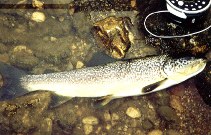| Family: |
Salmonidae (Salmonids), subfamily: Salmoninae |
| Max. size: |
120 cm SL (male/unsexed); max.weight: 50 kg; max. reported age: 10 years |
| Environment: |
demersal; freshwater, anadromous |
| Distribution: |
Europe: Adriatic basin from Po (only northern tributaries) to Soca and Rizana drainages (Italy, Slovenia). Introduced in Tevere drainage in Italy. Molecular data suggest that populations identified as Salmo marmoratus from Neretva drainage (Bosnia-Herzegovina, Croatia) and most likely those from Lake Skadar basin and Drin to Shkumbin drainages (Montenegro, Albania, Kosovoa, Macedonia) represent another species, as yet unidentified. Records from Croatia, Montenegro, Bosnia and Albania may be other subspecies of Adriatic trout and not of this marble trout (Lucijan Rejec, lrejec@ribiska-druzina-tolmin.si, pers.comm. 07/09). |
| Diagnosis: |
Distinguished from all congeners in Adriatic basin by having the following unique characters: body silvery to olive-green with irregular brown lines forming a marbled pattern; and no parr marks in individuals larger than 6 cm SL. Differs further by the combination of the following characters: red spots confined to lateral line, absent in some individuals and populations; opercle with brownish blotches or lines; head length 22-25% SL; eye diameter 1.7-2.2 times in interorbital distance, 3.1-4.3 times in postorbital length (at 25-35 cm SL) (Ref. 59043). |
| Biology: |
Inhabits cold streams and rivers in montane and piedmont landscapes with temperature usually not rising above 15° C during summer (Ref. 59043). Occurs over sandy and gravelly bottoms of running or standing clean and cold waters in the upper courses of Alpine rivers and glacial lakes (Ref. 12291). Feeds on a wide variety of aquatic and terrestrial invertebrates, shifting to fish diet when adult. Spawns in gravel of rivers and streams with swift water (0.4-0.5 m/s) at moderate depth (0.6-0.8 m). Lives up to at least 10 years. Threatened due to hybridization with introduced Salmo trutta and Salmo cenerinus, pollution, overfishing and river regulation. Only a few pure populations remain and stocking of pure strains has improved the situation. Conservation status is under least concern category, but might return to a threatened category if conservation measures end (Ref. 59043). |
| IUCN Red List Status: |
Least Concern (LC); Date assessed: 31 January 2006 Ref. (130435)
|
| Threat to humans: |
harmless |
Source and more info: www.fishbase.org. For personal, classroom, and other internal use only. Not for publication.

